Abstract
Cork granulated industries generate a considerable amount of wastes, such as grinding powder and granulometric separation powder. Some of these industries have started using these wastes as fuels for their own boilers, mixing them previously. However, there are differences between both wastes, especially the high moisture of grinding powder. This fact causes stratification during storage and makes boiler feed and its control more difficult, due to the heterogeneity of the resulting fuel. In the present research work, an overall study for combined pelletizing of these two wastes was carried out, with the aim of assessing their use in the same industries where they were generated or for other industrial uses. Thus, the optimum conditions for the highest yield of the pelletizing process were determined, and an analysis of the dry residue from grinding powder was carried out. Finally, the total specific energy was determined for the whole process. Among the main findings, it should be pointed out the obtaining of pellets with suitable physical properties and the high ash content that makes its possible commercialization difficult. Concerning the specific energy used, most of it corresponded to the drying process of grinding powder, recommending that it come from an exothermic process of cork granulated industry.
1. Introduction
In a global context where waste production is constantly increasing, its revaluation is becoming more and more important from an environmental and economic point of view. Terms such as by-product (replacing waste) are usually used, thanks to the implementation of steps that allow for a suitable recycling of wastes. Among them, the use of wastes as fuels takes part in a sustainable strategy.
The cork industry is not unfamiliar with this problem. There are around 2.5 million hectares of cork tree forest around the world, mainly in Portugal, Spain, Algeria, and Morocco. Spain is second in worldwide cork production (23%), led only by Portugal (50%) [1]. In general, manufacture is oriented to making cork stoppers, and many products are related to this item. The process starts with cork sheet boiling for an hour, with the aim of increasing its thickness, flexibility, and elasticity. Afterwards, a classification is carried out, assigning for each cork sheet a destination according to their quality and thickness. Sheets that are suitable for cork stopper manufacture or natural cork washers are sent to finishing industries, where these elements are obtained by direct perforation. The remaining cork sheets are sent to granulated industries, where they are ground as a previous step for agglomerated cork stopper manufacture.
As a consequence of this process, cork industries produce a considerable amount of solid wastes, and a suitable management of them is needed. Grinding powder and granulometric separation powder wastes are produced in granulated industries, being 97% of total solid wastes [2]. Grinding powder is generated during the grinding and milling stage of cork plates. Afterwards, another selection is done, in this case by density, in which the less dense particles (granulated cork) are separated from the densest ones, which are the so-called granulometric separation powder. Figure 1 shows an estimate of the ratios of the product and wastes that are generated in this kind of industries.
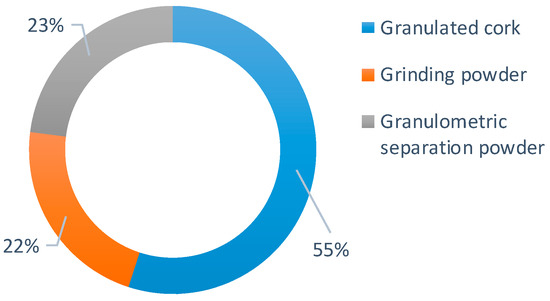
Figure 1.
Production and waste generated in cork granulated industries (own elaboration).
In that sense, energy use of cork wastes has been studied by many authors. Gil [3] carried out a physical-energy characterization of different kinds of cork powders, which included all of the wastes that are generated in transformation activities. Rojas et al. [4] proposed a selective storage of wastes for briquette manufacture and their subsequent use as a fuel in cork industries. Montero et al. [5,6] studied separately different wastes, pointing out the main properties of each product and its corresponding densification, with the aim of allowing a specific use. Nunes et al. [7] densified cork wastes of different granulometry, obtaining similar results when compared to forestry wastes.
The technique consisting in mixing wastes in order to obtain a complete use of them has been also researched. Mediavilla et al. [8] studied mixtures of wastes from cork industry and vine shoot wastes. The results showed that the addition of cork wastes improved pelletizing, reducing total energy used, and ash percentage, and increasing heating power, albeit physical properties were worse. Arranz [9] elaborated different mixtures of pyrenean oak, olive and grape pomace, and cork powder, in varying proportions, observing that the addition of pomace to pyrenean oak samples increased their heating power and bulk density. Serrano et al. [10] studied the effect of sawdust pine addition in pelletizing of barley straw, where the former acts as a binding agent due to its high lignin content, obtaining higher mechanical durability and a slight reduction in ash content.
Until a few years ago, wastes from the cork industry were placed in uncontrolled landfills. Gradually, companies were becoming aware of their thermal potential and started to store them in their own facilities in order to use these wastes as fuels in boilers.
However, there are large differences between both wastes (granulometry, bulk density, ash, etc.), especially when it comes to moisture. Whereas, granulometric separation powder is obtained with moisture values between 10% and 15% (wb), grinding powder usually exceeds 40% (wb), which implies lower combustion yields and makes its use in conventional boilers difficult. Similarly, these differences between both wastes cause stratification during storage, making boiler supply (and, therefore, its control) more difficult due to the heterogeneity of the resulting fuel [11]. As a result, the pelletizing of these wastes in the same facilities where they are generated could imply important advantages that are related with storage and maintenance cost reduction, as well as the obtention of a uniform fuel so that the combustion process is thoroughly controlled [12].
In general, some pre-treatments are needed to adapt raw materials to pelletizing conditions. Steps such as chipping, drying, grinding, and sieving are usual in the conversion of biomass to fuel. Both grinding powder and granulometric separation powder showed a suitable granulometry for pelletizing (particle size under 3.15 mm) [13,14]. However, the moisture of grinding powder was too high when compared to the values that are recommended in literature (around 15% wb), making drying the only pretreatment required in this case [15].
In this way, among the different innovative features of this research work, it should be pointed out that a technical and energy analysis of densification was carried out, including both the study of the drying that is necessary for one of the wastes and the pelletizing process. In turn, the densification of the wastes was carried out in semi-industrial equipment, which makes the extrapolation of the experimental results easier. The mixture of the wastes was done in the same proportion in which they are generated in cork industries, with the aim of promoting their energy use. The conditions for an optimal yield were determined for pelletizing, and then a drying test of grinding powder in order to get the optimum moisture level for pelletizing was carried out. Finally, the characterization of the pellets was carried out, with the aim of determining the most suitable use according to their properties.
2. Materials and Methods
2.1. Sampling and Preparation
The samples of the wastes were collected from a cork granulated industry located in the southwest of Spain. Grinding powder was obtained in an area next to the grinding mill, and granulometric separation powder was obtained directly from rejection areas in slightly-inclined and vibratory boards, with particle size values of 0.5–1 and 1–2 mm.
For each waste, 150–200 kg was selected and transported in bags to our facilities for their study. A small amount of sample (5 kg) was placed in hermetic bags for characterization assays. The remaining was used for pelletizing tests.
Figure 2 shows the wastes and particle sizes used in the present work.

Figure 2.
(a) Grinding powder; (b) 0.5–1 mm-size granulometric separation powder; (c) 1–2 mm-size granulometric separation powder (own elaboration).
Afterwards, initial moisture and bulk density were determined for the samples, following the methods described in UNE-EN ISO 18134-2 and UNE-ENISO 17828 Norms [16,17]. Before the pelletizing tests, a drying treatment was carried out, with the aim of reducing the high moisture of grinding powder. For this purpose, it was spread on drying areas, finishing the process when moisture values of 20% (wb) were obtained.
In order to mix the wastes, an industrial balance was used (GFK, Adam Equipment, Milton Keynes, UK). The raw materials were weighed to get the desired ratio (Table 1), putting them in a big-bag and mixing them manually until a uniform distribution was obtained.

Table 1.
Waste ratio used for mixing.
2.2. Pelletizing Process
The obtaining of the pellets was carried out by a pelletizer with a rotative flat die (MGL 200, Kovo Novak, Citonice, Czech Republic), 8.5 kW of power, and a maximum yield of 300 kg h−1 (information provided by the manufacturer for pine sawdust as raw material). The flat die is a horizontal disk with 6 mm-diameter holes. The rollers turn around their longitudinal axis on the surface of the flat die, generating high pressure on the product and forcing it through the holes, making its compaction possible. Figure 3 shows a representative diagram, where: product hopper (1); auger product (2); auger to flat die (3); moisture-control system (4); flat die structure (5); cooling drum (6); and, product return (7). In turn, State 0 and State 1 represent the flow mass of raw material at the beginning and the end of the process, that is, after water addition.
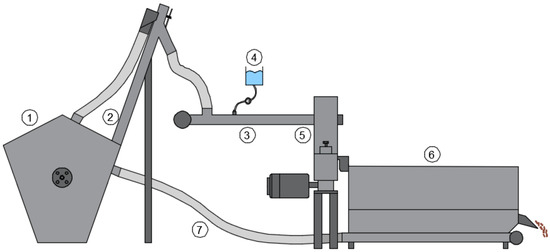
Figure 3.
Diagram of the pelletizer used (own elaboration).
In order to fix the tightening torque between the flat die and the rollers, a dynamometric key (Stahlwille 730N/10, Stahlwille Group, Wuppertal, Germany) was used, achieving 20 Nm. The pelletizing assays started after an initial heating of the flat die structure at around 85 °C. For this purpose, a digital thermometer was used (PCE-T390, PCE Ibérica, Albacete, Spain). Then, both mass flow and water addition were incrementally changed, keeping these conditions during 20 min intervals.
Afterwards, samples of the pellets at the final stage of each test (at around 10 min) were taken, with the aim of guaranteeing the stabilization of the process. Pellet production was determined by weighing. The efficiency of the process, EF, was defined as the relationship between the amount of manufactured pellets mP (kg) and the raw material used mR (kg) per unit of time, according to Equation (1).
During pelletizing, total energy used for this process was quantified through a power analyzer (PCE-PA 8000, PCE Ibérica, Albacete, Spain), connected to the electric panel. Thus, energy consumption for each pelletizing test was determined according to Equation (2), where EP is pelletizing energy (kWh), PP,i is the power of the pelletizer at an instant i (kW), and ti is the recording interval of this power (h).
Then, specific energy for pelletizing was determined for each test eP (kWh kg−1), defined as the relationship between energy consumption and pellet production, according to Equation (3).
2.3. Drying Process
Once the flow and moisture conditions for the samples, corresponding to the highest yield situation, were known, the specific energy that was used to dry the grinding powder waste was determined, taking into account its combination with the granulometric separation powder at 50%.
The drying tests for grinding powder were carried out through a convective dryer (CE130, Gunt Hamburg, Hanskampring, Germany), composed of four removable stainless steel trays, a drying channel (in order to heat the product and remove moisture), flow control through a heatable fan, and a digital balance to record weight loss. The convective dryer requires electricity.
Figure 4 shows the equipment: drying channel (1); drying plates (2); transparent door (3); process schematic (4); air velocity sensor (5); measuring point for humidity and temperature (6); digital balance (7); bracket for drying plates (8); measuring point with humidity and temperature sensor (9); switch cabinet with digital displays (10); fan (11).
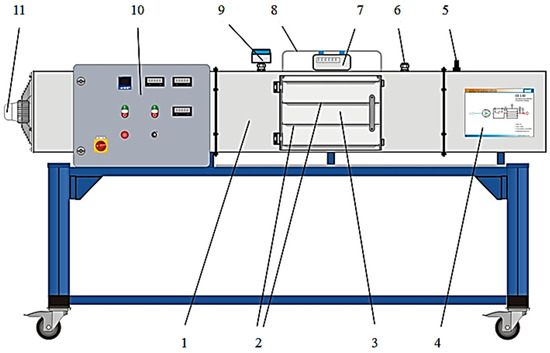
Figure 4.
Convection drying (from Gunt Hamburg Manual).
The procedure was the following: around 250 g of waste was spread on each of the four trays (1 kg in total), so that the thickness of sample on each tray was less than 1 cm. Several tests were carried out, with different drying air velocities (v = 0.8, 1.2, and 1.6 m s−1) and temperatures (T = 30, 40, and 50 °C).
Moisture content (M) determination was carried out following Equations (4) and (5), where ms is the dry mass (g), mw is the wet mass (g), m0 is the initial mass (g), and mt is the mass at time t (g). Also, when considering that the samples analyzed showed different initial moisture levels, and with the aim of comparing the drying kinetics regardless of initial moisture, moisture ratio (MR) was used in the present work. MR is defined as the quotient between moisture at time t, Mt, and initial moisture M0 Equation (6).
Finally, the specific energy required for drying eD (kWh kg−1), according to Equation (7), was obtained, where mD is the drying air flow (kg h−1), Δh the enthalpy difference of air between the inlet air into the drying chamber and room air (kJ kg−1), and ti is the interval between records (h).
2.4. Determination of the Total Energy Used in the Process
Drying pre-treatment is just necessary for grinding powder waste (50% of the mixture). Thus, the total specific energy of the process is given by the Equation (8):
2.5. Characterization of Pellets
For physical-energy characterization, the samples of pellets were taken when maximum productivity was achieved during pelletizing tests. Moisture tests were carried out by using a precision balance (accuracy ±0.1 mg) and a laboratory stove at 105 °C. Average sizes (diameter and length) were measured with a caliper. Mechanical durability tests were carried out by using a durabilimeter (BDM230, Mabrik, Barcelona, Spain), which consists of two rotatable boxes with smooth surfaces that rotate at 50 rpm. The ultimate analysis was carried out through an analyzer (Eurovector EA 3000, Eurovector SpA, Milan, Italy). For volatile and ash content, a muffle furnace, heated at 900 and 550 °C, respectively, was used. Fixed carbon percentage was determined by substracting the addition of the two former parameters from 100. Experimental high heating value (HHV, MJ kg−1) was done with a calorimeter (IKA C2000 Basic, Ika-Werke GmbH & Co., Staufen, Germany). Finally, theoretical low heating value (LHV, MJ kg−1 db) and energy density DE (MJ m−3 wb) were determined by using Equations (9) and (10), where H is hydrogen content (% db) and DB is bulk density (kg m−3 wb).
Table 2 shows the standards used in order to determine the properties of the manufactured products [18,19,20,21,22,23,24].

Table 2.
Standards used for the analysis.
Finally, the UNE-EN ISO 17225-2 norm for woody and industrial pellets [25] was used as a reference, which has three levels of quality. Table 3 shows the standard used in this work.

Table 3.
Specifications of the standard for pellets.
The characterization tests were done in triplicate, using the average value.
3. Results
3.1. Pelletizing Analysis
Densification consists in the compaction of a material in order to obtain homogeneous (concerning their size and properties) and denser fuels and with higher heating power, solving the initial disadvantages of their corresponding raw materials (low bulk density and difficulties for shipping and storage).
As a result of the preliminary characterization, grinding powder samples showed moisture levels of between 40% and 45% (wb), and this variation could be due to the different exposure of these wastes to the outside environment and storage times. Nevertheless, granulometric separation powder samples showed moisture values of around 10% (wb). This way, a drying pre-treatment for grinding powder was needed, reducing its moisture to 20% (wb). Thus, the mixture of these wastes showed a moisture value of 14.6% (wb) and a bulk density value of 448.5 kg m−3 (wb), with potential for increasing the latter through densification.
Table 4 shows the energy consumption recorded during the pelletizing process.

Table 4.
Energy used during the pelletizing process.
For mass flow values under 25 kg h−1, low yields were obtained, detecting high dust percentages. Similarly, values above 60 kg h−1 did not allow for a suitable agglomeration, causing continuous obstructions in the die flat. Nevertheless, for mass flows between both values high efficiencies were obtained, above 90% in all cases. This means that, under these conditions, most of the raw material is densified, returning a small quantity of dust, which implies energy and time saving during pelletizing.
On the other hand, it can be observed that the test with the highest flow corresponded to the highest energy use, being the expected situation. Thus, the higher the mass flow was, the higher the effort of the motor of the flat die was, which has to overcome the high friction that is created between the surface of the product and the pressure rollers. This extra effort implies higher power demand, as well as higher electric power consumption.
The decrease in eP at the maximum power has to do with an optimum distribution of the raw material on the base of the flat die. Thus, there is a flow of raw material for which the distribution of it on the surface of the flat die is optimum, obtaining higher energy costs, but also higher production. The analysis of these two magnitudes allows for the determination of the lowest specific energy value for pelletizing. Nevertheless, this assay corresponded to the highest yield (56.20 kg h−1), obtaining a low specific energy value (0.12 kWh kg−1). In this way, the conditions that enabled a higher production corresponded to a mass flow of 58.8 kg h−1 and 15.5% moisture (wb).
3.2. Drying Analysis of Grinding Powder
Due to the fact that the raw material was a mixture of 50% granulometric separation powder (moisture of value 10% wb) and 50% grinding powder, the optimum moisture for the latter should be around 21% (wb), so that the resulting mixture shows 15.5% (wb). This implies that grinding powder waste should present an MR value of 0.33 (db), approximately.
Figure 5 shows the evolution of moisture ratio during the drying tests. Also, Table 5 sums up the drying times and specific energy for drying.
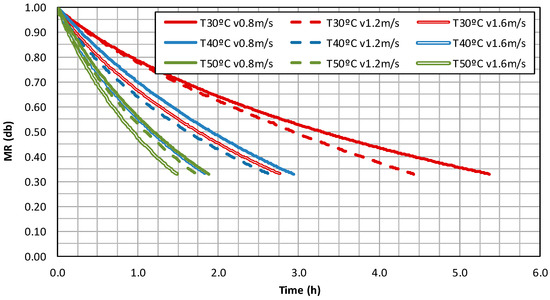
Figure 5.
Dependence between time and moisture ratio (MR) (db).

Table 5.
Specific drying energy of grinding powder.
For all the cases, with greater speed and higher temperatures of the drying air, shorter drying times were obtained. The effect of the increase in air speed was more marked at low temperatures. Thus, for T 30 °C, drying times were 17% and 48% shorter when compared to the lowest flow. However, for T 50 °C, drying times shortened 8% and 21% as air flow increased. This means that for high drying temperatures, the increase in air speed did not cause any substantial reduction in drying times (Figure 6).
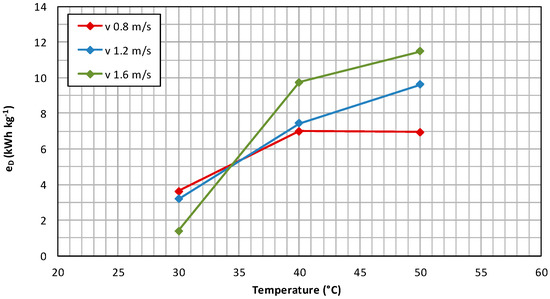
Figure 6.
Dependence between temperature and drying time.
In turn, an increase in temperature shortened drying times, regardless the air speed. For 30, 40, and 50 °C, there were reductions of 45% and 65% in drying times for v 0.8 m/s, 41%, and 61% for v 1.2 m/s and 34% and 44% for v 1.6 m/s, respectively.
Concerning specific energy for drying, for the tests at high temperature, higher values for this variable were found, due to the higher enthalpy difference between ambient and drying air. For 40 and 50 °C, faster air speeds implied higher specific energies. The most suitable combination for which the lowest energy use was recorded was the corresponding to T 30 °C and a drying air flow of 1.6 m/s (Figure 7).
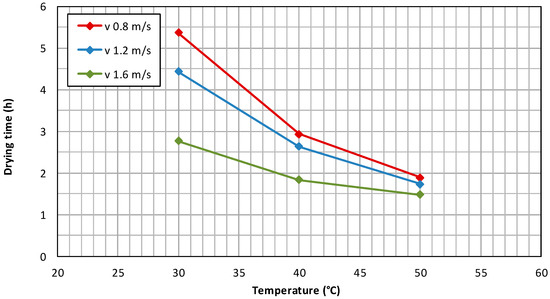
Figure 7.
Dependence between temperature and specific drying energy.
3.3. Determination of the Total Energy Used in the Process
Total specific energy of the process—drying and pelletizing—reached a value of 0.82 kWh kg−1. In this case, the cost of drying implied over 85% of the pelletizing process for this mixture, and it is necessary that the energy for this pretreatment come from some exothermic process of the industry in itself.
3.4. Pellet Characterization
Densification is based on the compaction of a material in order to obtain denser fuels, with high heating power and homogeneous materials in terms of properties and size, solving the drawbacks related to their corresponding raw materials (such as low bulk density and difficulties for transportation and storage).
Physical heterogeneity of wastes is derived from several factors, such as moisture, bulk density, granulometry, etc. Moisture in wastes depends on the amount of water in biomass and the separation or extraction process from the raw material. Thus, in wet fuels, some heat that is supposedly devoted to combustion is used to evaporate water, whereas in a dried fuel, all of the heat is entirely used to heat the air and combustion products. Therefore, this is a parameter that directly affects the effectiveness of combustion.
On the other hand, most biomass wastes show low bulk densities due to their porous structure, with values from 40 to 150 kg m−3 (wb) for herbaceous biomass and from 320 to 720 kg m−3 (wb) for softwood. Bulk density of wood chips, for example, ranges from 150 and 200 kg m−3 (wb) [26]. This fact makes processing, shipping, storage, and combustion difficult. High bulk density implies a great advantage when compared to other products, as it allows to store higher amounts of energy for the same volume. In that way, pelletizing is especially important, adding to the above-mentioned advantages a flowing behavior of the new biofuel (absence of arching or bridging in storage units) [27].
After the drying process of grinding power and its subsequent mixture with granulometric separation powder, the resulting raw material showed a moisture content of 14.60% (wb)—within the range recommended in literature, that is, 10–15% (wb)—and a bulk density of 448.52 kg m−3 (wb), being an intermediate value with possibilities to be increased by densification. Concerning granulometry, both wastes showed uniform particle sizes, with values less than 3.15 mm—which is the value that is recommended for pelletizing.
After the preparation and subsequent characterization of the mixture of wastes, pelletizing was carried out. Table 6 shows the main physical and energy properties of the manufactured pellets.

Table 6.
Properties of the manufactured pellets.
The pellets showed moisture percentages of 11.07% (wb), slightly higher than the upper limit (10%), even though there was 24% of moisture reduction during the process. On the other hand, bulk density of the pellets manufactured was around 698 kg m−3 (wb), which is higher than the lower limit and similar to those found for pyrenean oak pellets (742.50 kg m−3 wb) and mixture pellets from granulated cork (750 kg m−3 wb).
Concerning the densification ratio, it is a magnitude that shows the volume reduction of a product as a consequence of pelletizing, and therefore, an increase in its bulk density. Under normal conditions, starting with lower bulk densities implies higher densification ratios, due to the fact that the increase in this variable is higher. For the pellets that are manufactured, the densification ratio value was 1.56. This means that pelletizing of this mixture would allow for companies to reduce 1.5 times the volume in their stores, reducing in the same proportion shipping costs to consumption sites. This is an important logistical advantage that would improve the economic balance of companies.
On the other hand, higher compactions do not always imply higher durabilities or resistances to pressure or impacts. Thus, the amount of small particles in a sample made of pellets is given by the manufacturing process. After going through the flat die structure, both dust and bigger particles that did not densify properly come together with the pellets manufactured. Some of this dust is sucked back and sent to the hopper, whereas the remaining will stay with the manufactured pellets until they are delivered.
The presence of these particles affects the quality of the product, reducing its homogeneity and implying powdery and environmental problems when these fuels are used [28]. In this case, durability surpassed 97%, which is a value that is high enough to guarantee a right reception of pellets in consumption places.
The size of the pellets analyzed were within the limits of the norm consulted, which demands a pellet diameter between 6 ± 1 mm and a length between 3.15 and 40 mm. Concerning the length/diameter ratio (L/D), it is an important parameter, especially in pneumatic supply systems, due to the risk of conveyor pipe obstruction [29]. Although the UNE-EN ISO 17725-2 norm does not establish any restriction about it, other norms, such as the Austrian ÖNORM M 7135 [30], establish that this ratio should be less than 5. The manufactured pellets complied with that specification, with values of around 4.10.
Concerning nitrogen and sulphur content, the pellets that were manufactured showed similar values to those that were included in the standards consulted—I3 specification—not expecting any problems related to nitrogen and sulphur oxide emissions. In fact, nitrogen values of 1% (db) and sulphur values of 0.2% (db) are usually used as upper limits to ensure these emission levels [31].
Concerning ash content, the pellets manufactured showed values of 4.39% (db), slightly higher than the ash content of granulometric separation powder, and much less than the value for grinding powder (12.79% db). The similitude of the results to the former could indicate that the mixture of the wastes in the hopper, before pelletizing, was not uniform, and, possibly due to the fact that these wastes showed different grain size and density, the intake of the mixture by the screw conveyor was different over time.
Lehtikangas [32] carried out a study about the main characteristics of sawdust, forest wastes, and pine bark pellets, observing that ash content for the two latter (2.63% and 3.71% db) were much higher than pine bark ash content (0.45% db). Filbakk et al. [33] also analyzed ash content in pine wood, bark, and mixture pellets with percentages of bark of 5%, 10%, and 30%. The results showed ash content values of 0.47% (db) for wood pellets and 2.50% (db) for bark pellets, with values among the former for the different mixtures. In any case, the higher the bark percentage was, the higher the ash content was found. This reasoning could be valid for pelletizing of wastes in cork granulated industries, where wastes are usually composed of particles from cork bark.
In any case, ash content exceeded 3% (db), which is the upper limit, according to the norms consulted. The high ash content could imply a disadvantage concerning scorification and deposit formation in several points of the plant, with efficiency and reliability loss, being one of the lines for further research Works.
Concerning heating value, the samples showed LHV above 16 MJ kg−1 (wb), which is the lower limit that is included in the standards consulted for this research work. Finally, energy density of the mixture was increased after pelletizing, with the same abovementioned ratio.
Table 7 sums up the comparison of the manufactured pellets at three different quality levels according to the UNE-EN ISO 17725-2 norm for industrial use.

Table 7.
Comparison between pellets and UNE-EN ISO 17725-2 standard.
Thus, the moisture values obtained were slightly higher than the upper limit, whereas the durability value was slightly lower than the lower I1 limit (the most limiting one). These two drawbacks are easily solvable through the optimization of the pelletizing process—control of water addition, greater rejection in the cooling drum, etc. However, the high ash content—inherent in raw materials—could make the commercialization of these pellets difficult, limiting its use to cork granulated industry.
4. Conclusions
The most relevant findings in the present work were the following:
- The drying tests of the grinding powder wastes showed that, concerning the drying air, there was a higher influence of temperature than speed, obtaining higher specific energy consumptions for the drying process at higher temperatures.
- For the tests at low temperature, shorter drying times and less energy consumption were obtained for a higher speed of the drying air. This fact was not found at medium and high temperatures, where the reduction of drying times implied higher power consumptions.
- Pelletizing of the mixture of wastes from grinding powder and granulometric separation powder, in the same proportion as they are generated, is technically feasible. The pellets manufactured showed acceptable results concerning physical properties (moisture, bulk density, durability, and size), making a considerable reduction in storage needs and shipping costs to consumption sites. However, the pellets manufactured had too high ash contents, not complying with the norms consulted and making its commercialization for other facilities difficult.
- Concerning the specific energy of the whole process, most of it corresponded to the energy used for drying the grinding powder waste, and therefore the energy required for this pre-treatment should come from some exothermal process of cork granulated industry.
- Due to all these reasons, the most suitable use according to the characteristics of the pellets analyzed was for the industries that produce these wastes by themselves, by heating water for cork boiling or other similar thermal processes.
Acknowledgments
We would like to appreciate the Regional Government of Extremadura for the support to research groups (GR10151).
Author Contributions
Regarding the contribution of each author to the article, the original idea and work coordination corresponded to María Teresa Miranda and Irene Montero. The analysis of data was carried out by Francisco José Sepúlveda, José Ignacio Arranz and Carmen Victoria Rojas. Finally, the wording of the conclusions was made by Francisco José Sepúlveda.
Conflicts of Interest
The authors declare no conflict of interest.
References
- Agrupación Sanvicenteña de Empresarios del Corcho (ASECOR). Cork: Ecological, Sustainable and Recyclable. Available online: http://www.asecor.com/doc/elcorcho.pdf (accessed on 15 September 2017).
- Sepúlveda, F.J. Selective Use for the Integral Valorization of Wastes from Cork Industry. Ph.D. Thesis, University of Extremadura, Badajoz, Spain, 2014. [Google Scholar]
- Gil, L. Cork powder waste: An overview. Biomass Bioenergy 1997, 13, 59–61. [Google Scholar] [CrossRef]
- Rojas, S.; Pérez, C.; Montero, I. Energy recovery of waste from cork industries of San Vicente de Alcántara. Energy 2002, 166, 88–93. [Google Scholar]
- Montero, I.; Miranda, M.T.; Sepúlveda, F.J. Analysis of pelletizing of wastes from cork industry. Dyn. Energy Sustain. 2014, 1–13. [Google Scholar] [CrossRef]
- Montero, I.; Miranda, M.T.; Sepúlveda, F.J. Analysis of pelletizing of cork powder from industries of granulated. Materials 2014, 8, 1413–1427. [Google Scholar]
- Nunes, L.J.R.; Matias, J.C.O.; Catalão, J.P.S. Energy recovery from cork industrial waste: Production and characterisation of cork pellets. Fuel 2013, 113, 24–30. [Google Scholar] [CrossRef]
- Mediavilla, I.; Fernández, M.J.; Esteban, L.S. Optimization of pelletisation and combustion in a boiler of 17.5 kWth for vine shoots and industrial cork residue. Fuel Process. Technol. 2009, 90, 621–628. [Google Scholar] [CrossRef]
- Arranz, J.I. Analysis of the Densified Combination of Different Biomass Residues. Ph.D. Thesis, University of Extremadura, Badajoz, Spain, 2011. [Google Scholar]
- Serrano, C.; Monedero, E.; Lapuerta, M.; Portero, H. Effect of moisture content, particle size and pine addition on quality parameters of barley straw pellets. Fuel Process. Technol. 2011, 92, 699–706. [Google Scholar] [CrossRef]
- Rhén, C. Effects of raw material moisture content, densification pressure and temperature on some properties of Norway spruce pellets. Fuel Process. Technol. 2005, 87, 11–16. [Google Scholar] [CrossRef]
- Miranda, M.T.; Arranz, J.I.; Rojas, S.; Montero, I. Energetic characterization of densified residues from Pyrenean oak forest. Fuel 2009, 88, 2106–2112. [Google Scholar] [CrossRef]
- Mani, S.; Tabilb, L.G.; Sokhansanj, S. Effects of compressive force, particle size and moisture content on mechanical properties of biomass pellets from grasses. Biomass Bioenergy 2006, 30, 648–654. [Google Scholar] [CrossRef]
- Wolf, A.; Vidlund, A.; Andersson, E. Energy efficient pellet production in the forest industry—A study of obstacles and success factors. Biomass Bioenergy 2006, 30, 38–45. [Google Scholar] [CrossRef]
- Obernberger, I.; Thek, G. The Pellet Handbook—The Production and Thermal Utilisation of Pellets; Earthscan: London, UK, 2010. [Google Scholar]
- Solid Biofuels. Part 2: Total moisture. Simplified method. In Determination of Moisture Content by OVEN Dry Method; UNE-EN ISO 18134-2:2016; Spanish Association for Standardisation and Certification (AENOR): Madrid, Spain, 2016. [Google Scholar]
- Solid Biofuels. Determination of Bulk Density; UNE-EN ISO 17828:2016; Spanish Association for Standardisation and Certification (AENOR): Madrid, Spain, 2016. [Google Scholar]
- Solid Biofuels. Determination of Length and Diameter of Pellets; UNE-EN ISO 17829:2016; Spanish Association for Standardisation and Certification (AENOR): Madrid, Spain, 2016. [Google Scholar]
- Solid Biofuels. Determination of Mechanical Durability of Pellets and Briquettes. Part 1: Pellets; UNE-EN ISO 17831-1:2016; Spanish Association for Standardisation and Certification (AENOR): Madrid, Spain, 2016. [Google Scholar]
- Solid Biofuels. Determination of Total Content of Carbon, Hydrogen and Nitrogen; UNE-EN ISO 16948:2015; Spanish Association for Standardisation and Certification (AENOR): Madrid, Spain, 2015. [Google Scholar]
- Solid Biofuels. Determination of Total Content of Sulfur and Chlorine; UNE-EN ISO 16994:2015; Spanish Association for Standardisation and Certification (AENOR): Madrid, Spain, 2011. [Google Scholar]
- Solid Biofuels. Determination of the Content of Volatile Matter; UNE-EN ISO 18123:2016; Spanish Association for Standardisation and Certification (AENOR): Madrid, Spain, 2016. [Google Scholar]
- Solid Biofuels. Determination of Ash Content; UNE-EN ISO 18122:2016; Spanish Association for Standardisation and Certification (AENOR): Madrid, Spain, 2016. [Google Scholar]
- Solid Biofuels. Determination of Calorific Value; UNE-EN 14918; Spanish Association for Standardisation and Certification (AENOR): Madrid, Spain, 2011. [Google Scholar]
- Solid Biofuels. Fuel Specifications and Classes. Part 2: Grades Wood Pellets; UNE-EN ISO 17225:2014; Spanish Association for Standardisation and Certification (AENOR): Madrid, Spain, 2014. [Google Scholar]
- Stelte, W.; Holm, J.K.; Sanadi, A.R.; Barsberg, S.; Ahrenfeldt, J.; Henriksen, U.B. A study of bonding and failure mechanisms in fuel pellets from different biomass resources. Biomass Bioenergy 2011, 35, 910–918. [Google Scholar] [CrossRef]
- Miccio, F.; Barletta, D.; Poletto, M. Flow properties and arching behavior of biomass particulate solids. Powder Technol. 2013, 235, 312–321. [Google Scholar] [CrossRef]
- Gillespie, G.D.; Everard, C.D.; Fagan, C.C.; McDonnell, K.P. Prediction of quality parameters of biomass pellets from proximate and ultimate analysis. Fuel 2013, 111, 771–777. [Google Scholar] [CrossRef]
- Obernberger, I.; Thek, G. Physical characterisation and chemical composition of densified biomass fuels with regard to their combustion behaviour. Biomass Bioenergy 2004, 27, 653–669. [Google Scholar] [CrossRef]
- Önorm, M. 7135: Compressed Wood and Compressed Bark Natural State-Pellets and Briquettes, Requirements and Test Specifications; Österreichisches Normungsinstitut: Vienna, Austria, 2000. [Google Scholar]
- Van Loo, S.; Koppejan, J. Handbook of Biomass Combustion and Cofiring, 1st ed.; Twente University Press: Enschede, The Netherlands, 2003. [Google Scholar]
- Lehtikangas, P. Quality properties of pelletised sawdust, logging residues and bark. Biomass Bioenergy 2001, 20, 351–360. [Google Scholar] [CrossRef]
- Filbakk, T.; Jirjis, R.; Nurmi, J.; Hoibo, O. The effect of bark content on quality parameters of Scots pine (Pinus sylvestris L.) pellets. Biomass Bioenergy 2011, 35, 3342–3349. [Google Scholar] [CrossRef]
© 2018 by the authors. Licensee MDPI, Basel, Switzerland. This article is an open access article distributed under the terms and conditions of the Creative Commons Attribution (CC BY) license (http://creativecommons.org/licenses/by/4.0/).